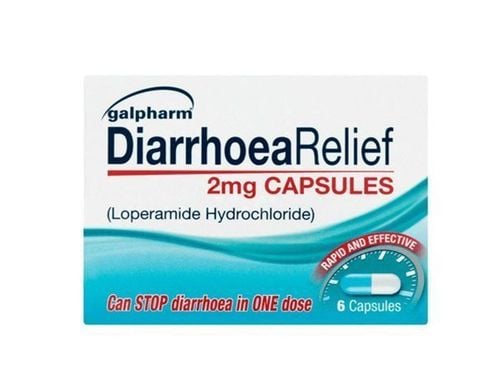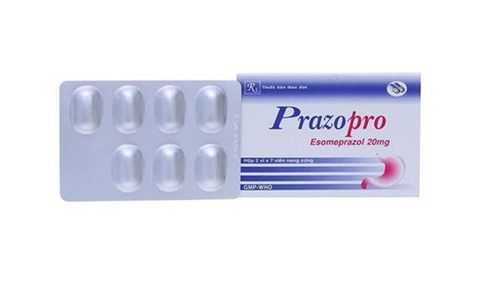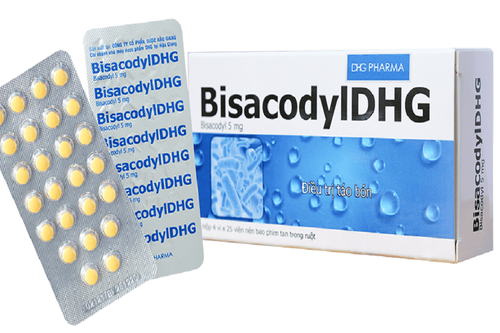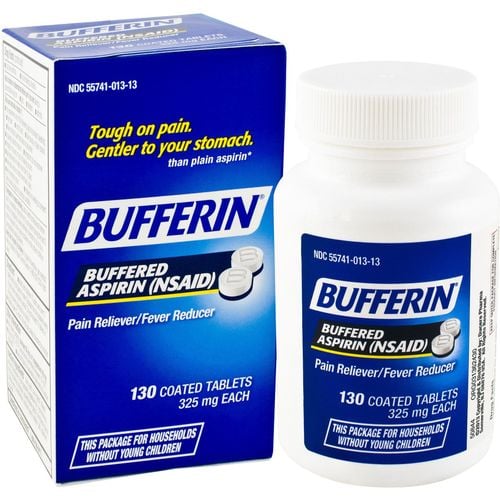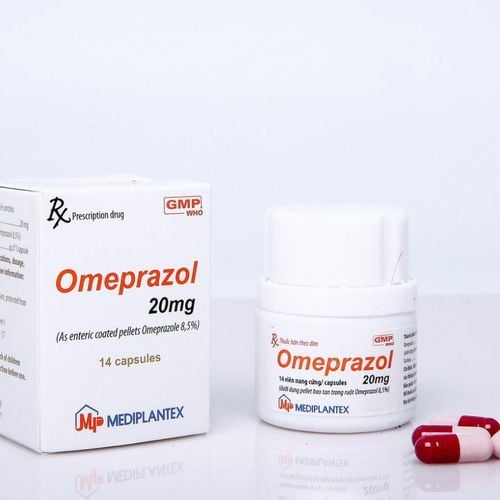This is an automatically translated article.
Prazopro is an antacid, anti-ulcer and anti-gastroesophageal or gastroduodenal medication. During treatment with Prazopro, patients need to strictly follow the doctor's instructions for taking the medicine to get rid of the disease soon.
1. What is Prazopro 20mg?
What is Prazopro 20mg? Prazopro contains esomeprazole as an active ingredient. Prazopro is manufactured by TV Pharmaceuticals. Pharm, prepared in the form of hard capsule No. 2, has a purple cap and body, the cap of the tablet is printed with 3 red arcs and the inside contains ivory or white enteric-coated granules.
Prazopro belongs to the group of anti-ulcer, anti-reflux and antacid drugs, packaged in a box of 2 blisters x 7 tablets. In addition to the 20mg dosage form, the product also has another form of Prazopro 40mg.
2. Indications and uses of Prazopro 20mg
2.1 Indications to use Prazopro 20mg medicine Prazopro is usually indicated for use in some of the following cases:
Treatment of peptic ulcer disease, bleeding due to severe peptic ulcer. Prevention of the risk of recurrent bleeding after endoscopic treatment of peptic ulcers. Prophylaxis and treatment of peptic ulcer disease caused by stress or taking non-steroidal anti-inflammatory drugs. Treatment of people with Zollinger–Ellison syndrome. Used in combination with the treatment of stomach ulcers caused by H. 2.2 Uses of Prazopro Pharmacodynamics
Active ingredient esomeprazole in Prazopro is the S-isomer of omeprazole, used to treat Zollinger–Ellison syndrome, peptic ulcer disease or gastroesophageal reflux disease – Esophageal. This active ingredient binds to H+/K+-ATPase in the parietal cells of the stomach, which specifically inhibits the enzyme system and prevents the final step of acid hydrochloride secretion into the gastric lumen. As a result, the active ingredient esomeprazole can inhibit the basic acid secretion activity of the stomach even when there is stimulation of other agents.
Prazopro is a long-acting drug with strong anti-ulcer and antacid effects. However, drugs belonging to the proton pump inhibitor group are only able to inhibit but not destroy Helicobacter pylori. Therefore, patients still need to use a combination of other antibiotics such as clarithromycin, amoxicillin or tetracycline to kill this bacteria effectively.
Pharmacokinetics
Following are the pharmacokinetic properties of Prazopro, including:
Absorption: The active ingredient esomeprazole is rapidly absorbed after oral administration, peak plasma concentrations are reached after 1-2 hours. . In addition, the bioavailability of this active ingredient may be increased with dose and with repeated administration, namely 68% with a 20 mg dose and 89% with a 40 mg dose of Prazopro. Distribution: According to studies, the rate of conjugation of esomeprazole to plasma proteins is up to 97%. The volume of distribution at steady state esomeprazole concentrations in the body is approximately 0.22 l/kg (in healthy subjects). Metabolism: The drug is extensively metabolised in the liver via the cytochrome enzyme system and the CYP2C19 isoenzyme. Once in the body, esomeprazole is converted to inactive desmethyl and hydroxy. The remainder of the drug is metabolized via the isoenzyme CYP3A4 to form esomeprazole sulfone. Elimination: The half-life of Prazopro is approximately 1.3 hours. The drug is eliminated mainly as inactive metabolites in the urine (80%), the rest is excreted in the feces, with less than 1% of the drug excreted in the urine.
3. Dosage and how to use Prazopro
3.1 Dosage of Prazopro The dose of Prazopro will be determined based on the patient's health condition, specifically:
Dosage for treatment of gastroesophageal reflux disease: Take 1 tablet / times/day. Dosage for treatment of Zollinger-Ellison syndrome: Take 1 time / day or divided into several times / day with a higher dose as prescribed by your doctor. Initial dose is 2 tablets (40mg) x 2 times / day, then adjust the dose if necessary. Dosage for treatment of peptic ulcer disease caused by Hp bacteria: Take 1 tablet / time, 2 times / day and maintain for 7 days. Treatment dose for peptic ulcer disease caused by non-steroidal anti-inflammatory drugs or stress: Take 1 tablet / day for 4 - 8 weeks. 3.2 How to use Prazopro medicine Prazopro medicine is prepared in the form of hard capsules, so patients need to take the drug orally, pay attention to swallow the tablet whole with water, avoid chewing or crushing the medicine.
Food can slow down and decrease the rate of absorption of the active ingredient esomeprazole. According to the study, the area under the AUC curve after taking a single dose of esomeprazole with meals decreased by 33-53% compared to the fasting. Therefore, you need to take Prazopro at least 1 hour before meals to achieve the best effect.
3.3 What to do in case of overdose or missed dose of Prazopro There is no specific antidote for esomeprazole overdose. In the case of an overdose of Prazopro, treatment will focus on supporting and improving symptoms. Because the drug is mostly bound to plasma proteins, hemodialysis is not capable of increasing drug elimination from the body.
In case you miss a dose of Prazopro, you need to take it as soon as possible. If it is almost time for your next dose, skip the missed dose and use it as planned. Making up for a double dose of the drug at the same time can cause dangerous overdose side effects.
4. Some side effects when using Prazopro
When using Prazopro, patients may experience some of the following side effects:
Common side effects such as diarrhea, abdominal pain, constipation, headache, nausea, vomiting, dry mouth, bloating a little bit. Less common side effects include red rash, urticaria, rash, dermatitis, dizziness, fatigue, drowsiness or insomnia. Rare side effects such as agitation, fever, sweating, depression, leukopenia, thrombocytopenia, taste disturbances, angioedema, stomatitis, jaundice, increased liver enzymes, impaired liver function, confusion confusion, hallucinations, arthralgia, myalgia, hyponatremia, porphyria, interstitial nephritis, gynecomastia, gastrointestinal infections,... You need to inform your doctor as soon as possible. when the body appears any reaction after using the drug. Early detection and treatment of symptoms caused by Prazopro will help patients avoid other health risks.
5. What other drugs does Prazopro interact with?
Prazopro may interact with some of the following drugs:
Ketoconazole, digoxin and iron salts when used with Prazopro can reduce the absorption of drugs. Cilostazol when co-administered with Prazopro may increase the concentration of cilostazol and its active metabolite. The drug voriconazole when used with Prazopro can increase the concentration of the active ingredient esomeprazole by 2-fold, this is especially noticeable in patients receiving a dose of 240 mg esomeprazole / day for the treatment of Zollinger–Ellison syndrome. When Prazopro is used with certain inducers of CYP3A4 and CYP2C19 (such as rifampin) there may be decreased concentrations of the active ingredient esomeprazole. Concomitant use of prazopro with loop diuretics or thiazides may increase the risk of hypomagnesaemia. Before starting Prazopro, patients should have their blood magnesium levels checked for an appropriate dose. Taking atazanavir with Prazopro may alter the absorption and plasma concentration of atazanavir, thereby reducing the antiviral activity of this drug. Prazopro should not be co-administered with clopidogrel as this may reduce the plasma concentrations of the active metabolite as well as the antiplatelet effect of clopidogrel. Concomitant administration of Prazopro with sucralfate may inhibit the absorption and bioavailability of the active ingredient esomeprazole, so patients should take Prazopro at least 30 minutes before taking sucralfate. When tacrolimus is used with Prazopro, the serum concentration of tacrolimus may be increased. Causes an increase in INR and prolongation of prothrombin time when the anticoagulant warfarin is used in combination with Prazopro. Concomitant use of Prazopro and clarithromycin should be avoided, as this may increase the concentration of the active ingredients esomeprazole and 14-hydroxyclarithromycin in the blood. Concomitant administration of diazepam and prazopro may increase plasma concentrations of diazepam and decrease its metabolism.
6. Some notes when using Prazopro
6.1 What precautions should be taken while taking Prazopro? In the process of using Prazopro, patients should note the following:
Use the drug exactly as prescribed by the doctor, not allowed to increase or decrease the dose at will. People with kidney disease or liver problems need to be careful when using Prazopro, it is best to consult a doctor. Before taking Prazopro, it is necessary to exclude the risk of stomach cancer because the active ingredient esomeprazole in the drug can hide symptoms and make it difficult to diagnose a tumor. Long-term use of Prazopro is not recommended because it can cause gastric atrophy. If Prazopro is stopped abruptly, the patient may experience a rebound acidosis, so patients should avoid abrupt discontinuation of the drug without the doctor's approval. During treatment with Prazopro, the patient should avoid eating spicy, hot, sour foods or alcohol-containing drinks, as they can easily irritate the stomach and make the disease worse. Because the drug can cause some side effects such as dizziness, headache, ... so the drivers of vehicles and machines need to be careful when using. Pregnant women should only use Prazopro when clearly needed and the benefits outweigh the risks. Prazopro should not be used by nursing mothers. 6.2 Contraindications to using Prazopro The following are cases to avoid using Prazopro, including:
People who are allergic to the active ingredient esomeprazole or are hypersensitive to any of the excipients in the drug. People who are allergic to benzimidazoles. People who are taking the drug nelfinavir. The use of Prazopro is contraindicated in people under 18 years of age. 6.3 Instructions for storing Prazopro medicine Prazopro should be stored at a temperature not exceeding 30 degrees Celsius, in a cool, dry place and out of the reach of small children. Medicines should be stored in a location out of direct sunlight or in a humid place such as a bathroom.
Prazopro is an antacid, anti-ulcer and anti-gastroesophageal or gastroesophageal reflux drug. During treatment with Prazopro, patients need to strictly follow the doctor's instructions for taking the medicine to overcome the disease early.
Follow Vinmec International General Hospital website to get more health, nutrition and beauty information to protect the health of yourself and your loved ones in your family.
Please dial HOTLINE for more information or register for an appointment HERE. Download MyVinmec app to make appointments faster and to manage your bookings easily.




